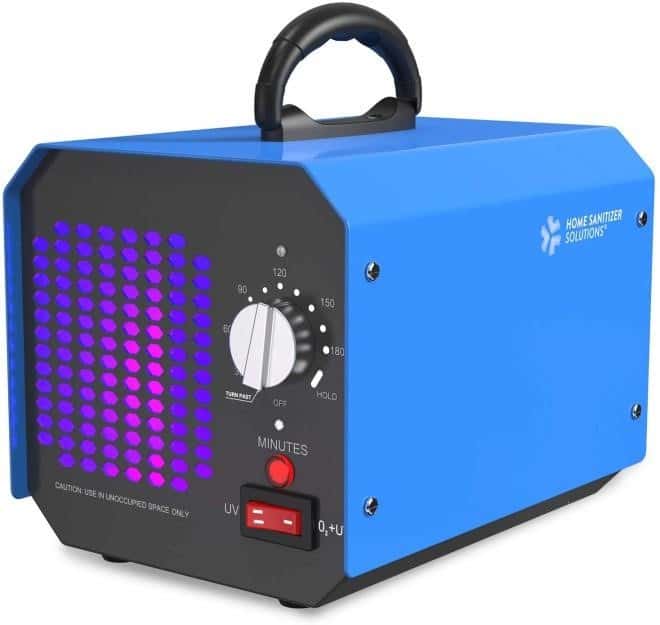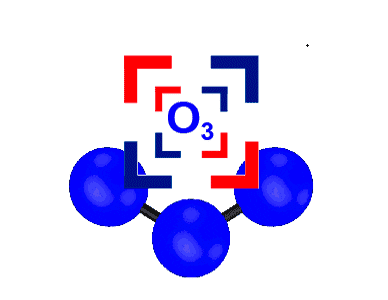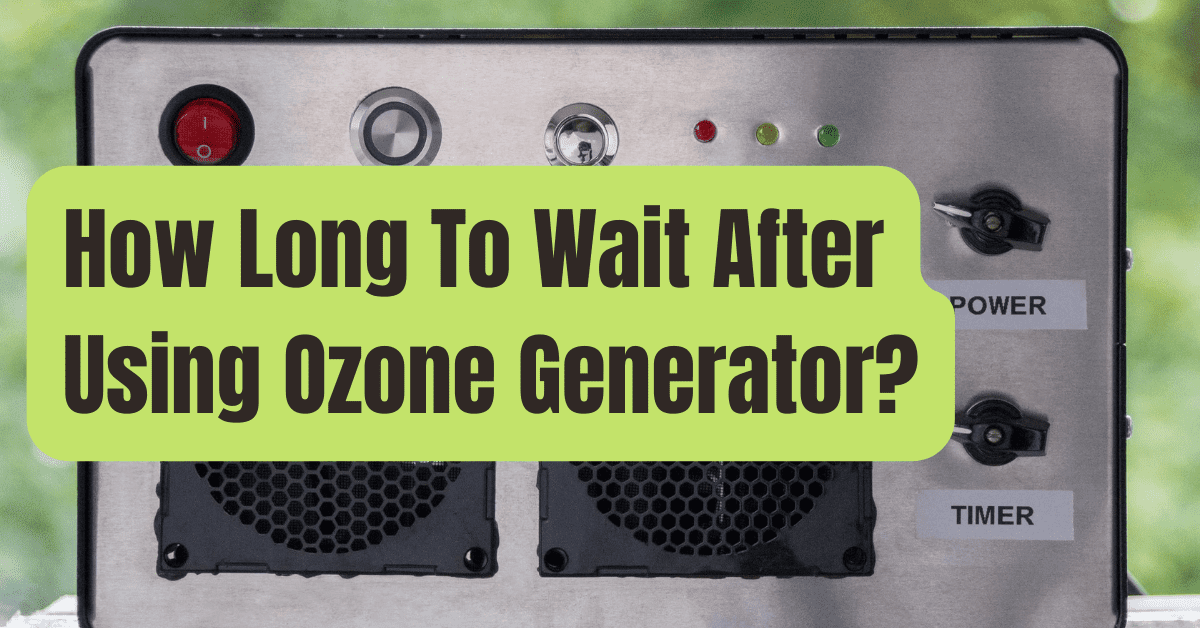After using an ozone generator, how long should you wait? Ozone lasts 30 minutes to 4 hours in the air before dissolving back into oxygen.
Higher amounts of ozone may take 3–4 hours to dissipate, although lesser quantities may take less than 2 hours.
It is recommended that you leave the room for at least 4 hours after using an ozone generator.
We’ll go over the hazards of ozone generators as well as how to use them properly in this piece.
When It Comes To Ozone, How Long Does It Last In The Air?
An ozone generator, as the EPA has repeatedly warned us, may be a lethal weapon.
If we had the choice, we would not start the machine, but that is not the objective of this essay.
What we have here is the official recommendation from most ozone producers.
We’ll go over everything you need to know about ozone, including how it disperses and interacts with bacteria.
By the conclusion of this article, you should have a general idea of how to use an ozone generator at home without causing too much damage.

How Long Should an Ozone Generator Be Left Running in a Room?
The ozone generator should operate for at least 3 to 10 hours, depending on the size of the space.
To remove the bulk of pollutants from a full home, at least 25-30 hours of continuous operation is necessary.
Avoid staying in the room when an ozone generator is running and locate another location to stay.
When Ozone Dissipates, How Long Does It Take?
Ozone may last anywhere from 30 minutes to 4 hours before the third oxygen atom breaks away and converts back to oxygen.
At lower concentrations, ozone generally takes 30 minutes to 1-2 hours to decompose into breathing oxygen.
At higher concentrations, ozone takes 3-4 hours to decompose into ordinary oxygen.
Return to the room after turning off an ozone generator for at least 4 hours to be safe.
Room size, temperature, dust, and pollution all impact ozone dispersion in the air.
To learn how long you should wait after utilizing an ozone generator and how it may help you lower the rate of pollution in your house, click here.
What Are the Signs of an Ozone Leak?
For monitoring ozone levels in a house, there are two common approaches.
Draeger Gas Detection Tubes (Draeger-Tubes) are the first, and they can detect a broad spectrum of gases.
In the range of 0.01-0.03 ppm, humans become sensitive to residual ozone.
Draeger tubes are glass vials that contain a chemical reagent that interacts with a variety of chemicals, including ozone.
A calibrated 100ml sample of air is extracted via the tube using the manual internal bellows pump.
A portable or wall-mounted ozone detector or air quality meter is the second approach.
The device’s built-in sensor will measure the ozone level in a room or house.
Simply set the gadget in the appropriate location for a few minutes to see the findings on the digital display.
How to Operate a Home Ozone Generator
All living species, including people, plants, and pets, are particularly vulnerable to ozone inhalation.
It kills bacteria, odors, mildew, and even insects crawling under the bed.
If you’re compelled to use an ozone generator because you’ve exhausted all other options, be sure you read the product paperwork first.
Every ozone generator is unique, with its own set of traits and qualities.
If you’re using an Ozonator for the first time, please sure to follow all of the safety precautions listed below.
- No living things are allowed: Never remain in the same room with an ozone generator running. If you want to cover the whole home, find a location to stay while the device is operating.
- Set a shutdown timer: The majority of Ozonators include a built-in timer that may be used to turn the device off when the timer runs out. If your gadget doesn’t have a timer, cover your mouth/nose and turn it off manually.
- Cover or remove valuable items when an ozone generator is active: With ozone atoms, metals and paper do not mix well. If feasible, cover bigger things with a blanket.
- Wait at least 4 hours before re-entering the room that has gone through ozonation: Ozone takes around 30 minutes to settle down and transform back into oxygen. The longer you wait, the fewer ozone gases are likely to stay in your house.
- Do not run an ozone generator in a highly humid environment: The wetness will harm the arcing within the machine. The machine, on the other hand, may be set to either a warm or a cold setting.
- Regular maintenance: A collecting plate on certain ozone generators has to be cleaned every two to six months. If you’re a heavy user, look for fine dust or oily residue on the output area, since this will affect the machine’s performance and longevity.
4 Expert Tips for Determining How Long to Wait After Using an Ozone Generator
While ozone generators can pose a safety concern, there are ways to mitigate the danger by correctly using the equipment.

#1. Examine Your Instructions
Ozone pollution poses a threat to humans, plants, and animals alike.
If you’re going to use an ozone generator, be sure you read the manual and understand how to use it properly.
Close the door and cover the vents with a cloth or tape while utilizing an ozone generator in a solitary room to keep them separated from the other rooms.
Make sure everyone is out of the home if you’re planning to apply it on the whole house.
#2. Decide How Long You Want To Run It For.
On average, an ozone generator should operate for 3-6 hours; however, this varies depending on the number of rooms to be cleaned.
If you’re cleaning a whole home, let the air conditioner or vents to pick up the ozone and disseminate it throughout, which should take around 26 to 30 hours.
#3. Make Use Of The Timer On Your Ozone Generator.
The timer on most current ozone generators ranges from 20 minutes to 8 or 10 hours, and when the timer runs out, the generator turns off.
These timers are beneficial because they enable you to switch off equipment without entering the ozone zone.
If you have to re-enter the area because your generator does not have a timer or the timer does not work, cover your mouth and nose with a towel and hold your breath.
Ozone may be harmful to your health if you breathe it in.
After then, switch off the ozone generator and quickly leave the room.
#4. Wait A While Before Returning To The Room.
You’ll have to wait a bit before entering an ozone-filled area since it’s dangerous to your health.
The ozone settles and the molecules separate after 2-3 hours, returning to regular, safe-to-breathe oxygen.
Wait a few hours after shutting off an ozone generator before turning it back on.
What is Ozone’s Role in Contaminant Elimination?
Ozone is a reactive oxygen molecule that interacts with everything it touches.
As a consequence, ozone has the ability to destroy germs, viruses, and tiny insects such as bed bugs and cockroaches.
Ozone may help eradicate the smells of cigarette smoke, mold, and mildew by oxidizing them.
Allergens and smoke will irritate the skin and create discomfort, which will be alleviated.
If the odor sources, such as mildew, mold, and chemical substances, are not removed, the odours will return.
Ozone has a half-life of roughly 30 minutes, which is rather short.
It will form an inert gas by reacting with other gaseous elements.
Ozone will gradually deteriorate if nothing is done, releasing the additional oxygen atom and reverting to Oxygen (O2).
Before we begin, let’s get this off our chests.
Because an ozone generator is not an air filter, it should not be used at home.
It creates ozone, a smelly gas that is harmful to our lungs.
Worse, ozone reacts violently with other chemicals, leading in the release of even more dangerous gases.
Consider getting an ozone-free HEPA air purifier instead of an Ozonator, which is effective while offering no health hazards.

Ozone Generators’ Risks
Ozone generators may hurt people since the chemical properties that enable it to react with malodor molecules also allow it to react with similar organic compounds in the body.
Despite being a natural gas, ozone is a dangerous gas having significantly different chemical and toxicological characteristics than oxygen, according to the US Environmental Protection Agency.
The body may be harmed by this harmful gas in the following ways:
- Coughing
- Pain in the chest
- Inflammation of the throat
- Breathing problems
- Chronic respiratory disorders are becoming worse.
- Damage to the lungs
- Breathing difficulties
- Putting the body’s capacity to combat respiratory illnesses in jeopardy.
To limit human exposure to ozone, many federal authorities have issued health rules or recommendations.
According to the Food and Drug Administration, indoor medical equipment must emit no more than 0.05 parts per million (ppm) (FDA).
Workers cannot be exposed to an average concentration of more than 0.10 ppm for more than eight hours, according to Occupational Safety and Health Administration (OSHA) standards.
You should never surpass 0.10 parts per million, according to the National Institute of Occupational Safety and Health (NIOSH).
Alternatives to Ozone Generators: Hydroxyl Generators
As you can see, utilizing an ozone generator properly demands taking certain measures and exiting the area.
With fewer safety issues and more flexibility, a hydroxyl generator can handle the same difficulties, but it may take a bit longer.
The repair and cleaning process must come to a stop every time the ozone generator is switched on, and the area must then be aired out.
An ozone generator may not be the quickest answer with all of the other restoration operations in the region beginning and ending.
Hydroxyls are often utilized because they may lessen or eliminate claims for business interruption.
Hydroxyl generators produce hydroxyl radicals, which break down odor compounds.
These hydroxyl molecules convert contaminants to carbon dioxide and water.
Hydroxyl generators, like ozone generators, remove odor-causing molecules, so removing the source of the issue.
Unlike ozone, however, hydroxyls are completely safe to humans, pets, plants, and other home items, therefore a hydroxyl generator may be kept running while other repairs are completed.
This also removes the need for evacuation since hydroxyl generators may begin producing hydroxyl immediately.










